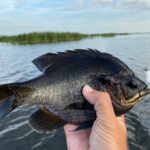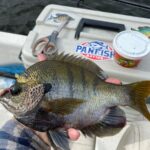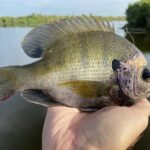In the world of freshwater fishing, perhaps nothing is more iconic than catching bluegill from their beds during the summer.
It’s one of my favorite ways to fish, becuase its relaxing, challenging and great action for the whole family.
In this guide, ill tell you how to find bluegill beds and answer a few commonly asked questions about the bluegill spawn so you can be more successful on the water.
Table of Contents
How To Find Bluegill Beds
Locating bluegill beds on any body of water might seem like a daunting task considering the vast size of most lakes or rivers. However, knowing what depths, structure, and bottom to look for can drastically narrow the search.
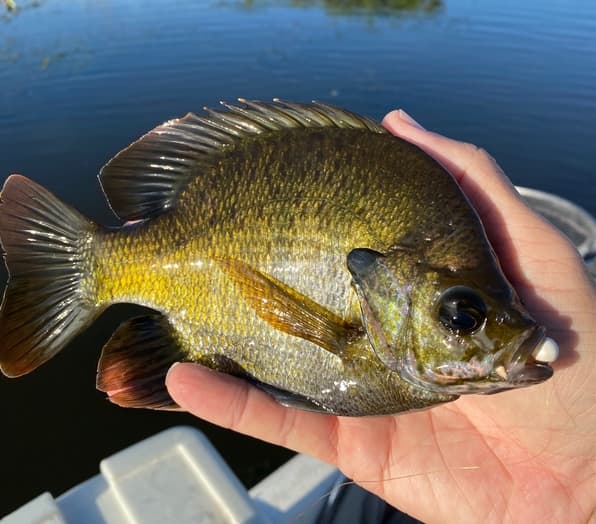
A good starting point when looking for a bluegill bed is to find flat, shallow water anywhere from 4 to 6 feet. The depth that bluegill bed at depends on the clarity, or turbidity, of the water.
In clear bodies of water, it is common to see bluegill bedding 12 feet deep. The opposite could be said for cloudy or muddy water, bringing bluegill as shallow as 12” to bed.
Another good indicator of a nearby bluegill bed is vertical structure. Stake beds and wooden dock poles offer just enough shade to attract baitfish but enough sunlight to develop the eggs. Short eelgrass is also an excellent habitat for bluegill beds, given it is not too thick.
The bottom of the river and lake plays a significant part in where bluegill likes to bed. You can count out bluff bottoms, tall grass, and mud.
The ideal bottom for bluegill to bed is a soft, gravel bottom. This allows them to form the bed easily but is strong enough to hold its structure.
Where I live in Florida, that usually means shell bottom, or general hard bottom like limestone.
If you can find the common theme among these three components, there is a pretty good chance you will find the beds.
See Also: What Exactly Do Bluegill Eat?
Another Tip To Finding Bluegill Beds
On lakes and bodies of water where the water clarity is to poor to see the beds visually, I have two pro tips for ya:
Use A Probing Rod
Bring along a 6 foot fiberglass or metal rod. When you think your in a good area, probe the bottom to check the consistency.
If the rod pushes into the bottom easily with little resistance, its probably mud or muck (not suitable habitat for bluegill beds). Keep checking.
However, if you probe the rod into gravel, rocks or shell you will hear and feel a ‘tink’ sound. This is a good sign your in the correct area.
Watch For Tail Bumping Reeds and Pads
When bluegill fan out their beds, they spend a lot of energy defending the nest and keeping it clean and tidy.
If you watch carefully, you can sometimes see the bluegill ‘bump’ into reeds and other rooted plant structure as they swim, fan and feed under the cover.
This technique works best on calm mornings, but scan around and if you see the vegetation getting ‘bumped‘ or slightly moving…I bet its a bluegill!
What Do Bluegill Beds Look Like?
Depending on the depths of the beds, you might be able to see them from above the water. Often mistaken for a sunken car tire, a typical bluegill bed will be around 16” in diameter and hold the shape of a near-perfect circle.
The outside of the bed will reach only a couple of inches tall in slow-moving water and up 6 inches in faster-moving water. When the bluegill makes the bed, he will pick a spot and push the rocks and mud out to form the shape.
This creates a bowl-like structure keeping the eggs hidden from distant predators and safe from the current.
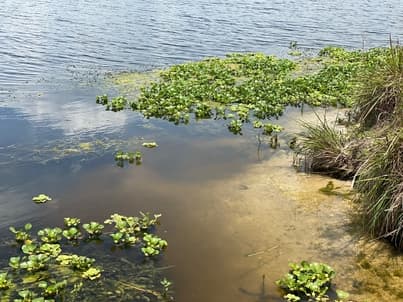
If you find one bluegill bed, you are sure to find many more. Bluegill like to spawn in clusters to help protect the eggs from predators. You can find clusters of bluegill beds anywhere from a 2 or 3 up to over 100. However, most clusters will have around 8 to 10 beds in them.
And if you are lucky enough to find a ‘bluegill nest’ of beds, mark it on your GPS! Bluegill will often return to the same areas to spawn year after year, as long as the habitat remains the same.
Finding Bluegill Beds On Side Imaging
Finding bluegill beds using side image is one of the best ways to locate them. Once you have pinpointed an area with suitable habitat, scan the area with one side of your side imaging, making sure not to get close enough to spook the fish.
You can use the numbers indicating the distance of the side image beam to ensure that you can see the beds but not run over the fish. A distance of 20 feet is a good reference point when looking for them.
You May Also Like: Garmin Livescope…Is It Really Worth The Money? Pros and Cons!
The beds on the screen will look like several small holes on the bottom. You will notice randomness to the cluster of beds, assuring that it is natural and not man-made. There are also lots of good youtube videos showing this technique.
How Long Do Bluegill Stay On Beds?
Beginning in mid-May and extending through early August, bluegill will spawn all summer using different beds. Like many other animals in the wild, spawning will correlate with the moon cycles. The typical time for bluegill to use one specific bed is ten days.
The five days before and after a full moon is when bluegill are most likely to bed. Of course, there will be other bluegill bedding in between full moons, so don’t limit yourself to fishing for them exclusively.
Can You Really Smell Bluegill/Bream Beds?
Ask any old-timer down at the bait shop, and he will put his bottom dollar on the fact you can smell bream beds. Often described as a ripe watermelon-like aroma, this smell is supposed to indicate that a bream bed is nearby.
At the risk of angering a whole generation, the claim is scientifically proven false. Like other fish beds at any depth below the water, we can not pick up the scent of fish spawning. But that doesn’t mean there isn’t a specific smell associated with bluegill beds.
Since bluegill and bream stay on bed according to the moon phase, there are certain plants that bloom during the same time that put off potent aromatics.
The claim that there is a sweet-like smell in the air when bluegill is on bed can certainly be justified. Only it’s not the spawning fish that we were all told as a kid, its the flowers and summertime armoas.
You May Also Like: The Top 10 Bluegill Lures Of All Time
If you haven’t guessed yet, I love fishing and everything about it!
To learn more about why I started Panfish Nation, visit the About page and follow along on Social Media:


Download a copy of my FREE Lure Color Selection Chart & Knot Guide!
Stay up to date with fishing reports, tackle reviews, industry news, and much more! We respect your privacy, unsubscribe at any time.
Related Posts
- Crazy Facts About the World Record Crappie
- What Size Hooks for Smallmouth Bass? Quick Guide
- Large and in Charge-Mouth: 10 of the Best Bass Lures of All Time (And Where to Buy Them)
- Emperor of the Sun(fish): What You Need to Know About the World Record Bluegill
- Coppernose Bluegills: How They’re Different from Common Bluegill
- Bluegill vs Brim: Differences & Terminology, Explained!




